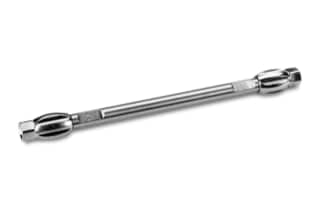
|
Chemistry |
Phenyl |
|
Separation Mode |
Reversed Phase |
|
Particle Substrate |
Hybrid |
|
pH Range Min |
1 pH |
|
pH Range Max |
12 pH |
|
Maximum Pressure |
6000 psi (415 Bar) |
|
Endcapped |
Yes |
|
Bonding Technology |
Phenyl-Hexyl |
|
Silanol Activity |
Low |
|
Particle Shape |
Spherical |
|
Particle Size |
3.5 µm |
|
Endfitting Type |
Waters |
|
Pore Size |
130 Å |
|
Format |
Column |
|
Surface Area |
185 |
|
System |
HPLC |
|
Particle Technology |
BEH |
|
USP Classification |
L11 |
|
Inner Diameter |
2.1 mm |
|
Length |
100 mm |
|
Carbon Load |
15 % |
|
UNSPSC |
41115709 |
|
Brand |
XBridge |
|
Product Type |
Columns |
|
Units per Package |
1 pk |

XBridge BEH Phenyl Column, 130Å, 3.5 µm, 2.1 mm X 100 mm, 1/pk
XBridge BEH Phenyl columns complement C18 stationary phases, particularly for polyaromatic chemicals. This is the most chemically stable commercially available Phenyl sorbent available, with ultra-low column bleed, long column lifetimes, and superb peak shape. The XBridge BEH Phenyl Column is known for its distinct features, which include increased column longevity, enhanced column reliability, and remarkable particle efficiency, resulting in unparalleled peak form and capacity.
BEH Columns from XBridge are intended to boost productivity. Unlike ordinary phenyl liquid chromatography columns, the XBridge BEH Phenyl Column has a wider pH range, enabling more robust technique development. This is made feasible by the end-capping and unique bonding of the BEH particle technology on which the XBridge BEH Phenyl Column is built. The trifunctional bonding of the phenyl ligand permits the analytical column to have excellent low and high pH stability.
The best lab equipment will help you work more productively. The XBridge BEH Phenyl Column is built under stringent controls to ensure the highest industry standards are fulfilled, resulting in lab equipment you can rely on reliable results batch after batch. The analytical column is produced in the Waters chromatography chemistry manufacturing plant under the most stringent cGMP, ISO 9002 requirements.
Check out our shop for lab equipment to discover more about variations of the same product, such as the XBridge BEH Phenyl Column listed in this post, or to locate additional lab equipment that works well with it; you may browse around our website, refer to our catalog, and ensure your lab needs are covered as needed and connect with a member of our support team for assistance as well.
You might also be interested in the XBridge BEH Phenyl VanGuard Cartridge, 130Å, 3.5 µm, 2.1 mm X 5 mm, 3/pk; these cartridges are intended to increase analytical column lifetime and performance by eliminating particle pollution from the mobile phase stream. This cartridge has been designed to protect all 2.1 mm and 3.0 mm I.D. XBridge BEH Phenyl analytical columns with 3.5 µm sorbent particles.
How Much Operating Pressure And What pH Range Can The XBridge BEH Phenyl Column Handle?
The XBridge BEH Phenyl Column can withstand operating pressures of up to 6000 psi (or 415 Bar) and pH ranges of 1 to 12. However, working at extreme pressures, pH, and/or temperatures will result in shorter column lifetimes; therefore, it is always advisable to run your experiment under standard conditions as needed.